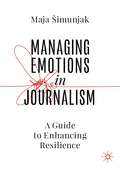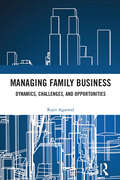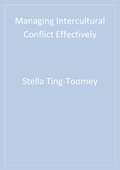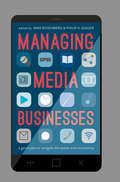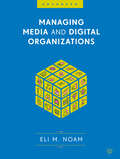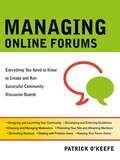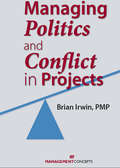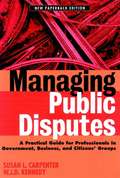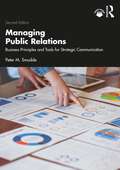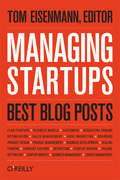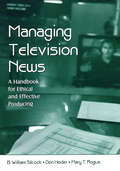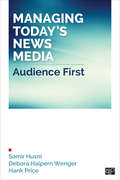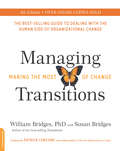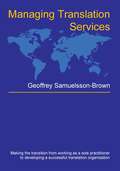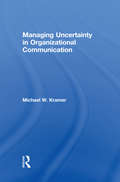- Table View
- List View
Managing Emotions in Journalism: A Guide to Enhancing Resilience
by Maja ŠimunjakThis textbook offers the first practical guide to managing emotions in everyday journalism work based on interviews with more than 30 British journalists. It raises awareness of emotional situations and stressors journalists may face, so practitioners are better able to recognise these and prepare for them, and outlines practical emotion management strategies which they can apply to enhance their emotional intelligence and resilience and consequently, feel and perform better in the workplace. It includes vignettes written by journalists from the United Kingdom, United States, Australia and Croatia, as well as practical scenario exercises that prompt readers to reflect on how they would feel and react in specific situations based on journalists’ everyday work.
Managing Environmental Conflict: An Earth Institute Sustainability Primer (Columbia University Earth Institute Sustainability Primers)
by Joshua D. FisherConflicts frequently arise over environmental issues such as land use, natural resource management, and laws and regulation, emerging from diverging interests and values among stakeholders. This book is a primer on causes of and solutions to such conflicts. It provides a foundational overview of the theory and practice of collaborative approaches to managing environmental disputes.Joshua D. Fisher explains the core concepts in collaborative conflict management and presents a clear, practical, and implementable framework for understanding and responding to environmental disputes. He details strategies to bring stakeholders together in pursuit of collective solutions, emphasizing ongoing processes of dialogue, analysis, action, and learning. This collaborative approach can create new opportunities for stakeholders to better understand each other and the natural world, which enables more effective and context-appropriate environmental governance. The primer examines why and how system dynamics can constrain or expand the possibility of constructive management of conflicts. It features a case study from the Amazon Basin, where local communities, extractive industry operators, conservationists, and land managers have often clashed over access to natural resources, drawing out lessons to illustrate how to adapt the conflict management framework to distinct contexts.Managing Environmental Conflict synthesizes knowledge, methods, and practices spanning consensus building, collaborative governance, complex adaptive systems science, environmental conflict resolution, and environmental peacebuilding. Its presentation of this important and timely topic will be invaluable for academics and practitioners alike, including decision makers, scientists, and conflict management professionals.
Managing Family Business: Dynamics, Challenges, and Opportunities
by Rajiv AgarwalThis book explores the unique characteristics and complexities of family businesses in India. It examines the intersection of family dynamics, cultural norms, and business practices, to offer valuable insights on how family businesses evolve, develop, grow, and sustain over time. With a focus on leadership and positioning for the future, this book illustrates how the family enterprise can achieve sustained growth and continuity through generations. Covering a wide range of topics essential for understanding the Indian family business landscape, this volume: Studies succession planning and governance, managing family conflicts and harnessing innovation Analyses the various strengths and weaknesses of family businesses Shares insights on top-performing family businesses alongside the oldest businesses in India and across the world Emphasises and extensively discusses the role of women in the contemporary Indian business landscape Insightful and engaging, this book will be useful to students, researchers, and teachers in the fields of business management, commerce, and economics. It will also be an invaluable resource for present or potential family business owners, managers, professionals, and business consultants.
Managing Family Business: Dynamics, Challenges, and Opportunities
by Rajiv AgarwalThis book explores the unique characteristics and complexities of family businesses in India. It examines the intersection of family dynamics, cultural norms, and business practices to offer valuable insights on how family businesses evolve, develop, grow, and sustain over time. With a focus on leadership and positioning for the future, this book illustrates how the family enterprise can achieve sustained growth and continuity through generations.Covering a wide range of topics essential for understanding the Indian family business landscape, this volume: Studies succession planning and governance, managing family conflicts and harnessing innovation Analyses the various strengths and weaknesses of family businesses Shares insights on top-performing family businesses alongside the oldest businesses in India and across the world Emphasises and extensively discusses the role of women in the contemporary Indian business landscape Insightful and engaging, this book will be useful to students, researchers, and teachers in the fields of business management, commerce, and economics. It will also be an invaluable resource for present or potential family business owners, managers, professionals, and business consultants.
Managing Intercultural Conflict Effectively
by Dr Stella Ting-Toomey Dr John G. OetzelIn this volume, Ting-Toomey and Oetzel accomplish two objectives: to explain the culture-based situational conflict model, including the relationship among conflict, ethnicity, and culture; and, second, integrate theory and practice in the discussion of interpersonal conflict in culture, ethnic, and gender contexts. While the book is theoretically directed, it is also a down-to-earth practical book that contains ample examples, conflict dialogues, and critical incidents. Managing Intercultural Conflict Effectively helps to illustrate the complexity of intercultural conflict interactions and readers will gain a broad yet integrative perspective in assessing intercultural conflict situations. The book is a multidisciplinary text that draws from the research work of a variety of disciplines such as cross-cultural psychology, social psychology, sociology, marital and family studies, international management, and communication.
Managing Interpersonal Conflict
by William A. DonohueThis book explores the process of interpersonal conflict - from the initial decision as to whether or not to confront differences through to how to plan the actual confrontation. It deals extensively with negotiation and, where negotiation proves unsuccessful, with third-party dispute resolution. To avoid destructive or violent behaviour, Donohue emphasizes the importance of keeping conflicts under control and of focusing on the pertinent issues. He argues that the key to managing conflict is to address differences collaboratively so that the parties can create better solutions and, ultimately, strengthen their relationships.
Managing Interpersonal Conflict: Advances through Meta-Analysis (Routledge Communication Series)
by Mike Allen Barbara Mae Gayle Raymond W. Preiss Nancy A. BurrellManaging Interpersonal Conflict is a systematic review of conflict research in legal, institutional and relational contexts. Each chapter represents a summary of the existing quantitative social science research using meta-analysis, with contexts ranging from jury selection to peer mediation to homophobia reduction. The contributors provide connections between cutting-edge scholarship about abstract theoretical arguments, the needs of instructional and training pedagogy, and practical applications of information. The meta-analysis approach produces a unique informational resource, offering answers to key research questions addressing conflict. This volume serves as an invaluable resource for studying conflict, mediation, negotiation and facilitation in coursework; implementing and planning training programs; designing interventions; creating workshops; and conducting studies of conflict.
Managing Media Businesses
by Mike Rosenberg Philip H. SeagerThis book is a practical guide to every aspect of managing media businesses. Written by a team of experts and illustrated with interviews from leading industry players, it addresses the unprecedented change and uncertainty facing the industry.Do newspapers, magazines or books have a future? Will terrestrial television or cable services exist as meaningful players in five years’ time? Is there a way to make multiple consumption platforms work together in a way that extracts the revenue needed to support the creation and development of quality content? While more and more content is being published, fewer and fewer businesses are finding a way to do so profitably and sustainably.Your answers to these questions that vex your media or entertainment business will depend on your frame – a frame based on experience gained in days that were less uncertain, less fluid and much, much simpler. Those frames need to be broken if you are to survive in times of such rapid change. This book is based on IESE’s Advanced Management Program in Media & Entertainment, which IESE Business School has been running in New York and Los Angeles since 2011. It combines contributions from leading professors and practitioners, as well as real-life case studies, to establish a base upon which you can start to build the set of managerial tools that you will need to manage fast-changing media and entertainment businesses.
Managing Media and Digital Organizations
by Eli M. NoamWhat does it take for success in the media business? Creativity, innovation, and performance, of course. Plus experience and good judgment. However, it also requires an understanding of the principles and tools of management. This book summarizes the major dimensions of a business school curriculum and applies them to the entire media, media-tech, and digital sectors. Its chapters cover—in a jargonless, non-technical way—the major management functions. First, creating a media product: the financing of projects and the management of technology, HR, production operations, intellectual assets, and government relations. Second, harvesting the product created: market research, marketing, pricing, and distribution. And third, is the control loop: media accounting and strategy planning. The book’s interdisciplinary approach goes beyond an industry-by-industry coverage and centers around management functions. In the process, this book becomes an indispensable resource for those aiming for a career in the media and digital field, both in startups and established organizations. It is also a work that helps advance the entire field—the management of information resources and products—to a more central role in business analysis. This book is designed to help those already in the sector or those joining it to become creative managers and managerial creatives. It aims to make managers in this field more knowledgeable, less blinded by hype, more effective, more productive, and more responsible.
Managing Online Forums: Everything You Need to Know to Create and Run Successful Community Discussion Boards
by Patrick O'KeefeEvery day, millions of users log on to their favorite online forums and interact with others to get advice and discuss everything from the latest news and trends to their hobbies, professions, and whatever else strikes their fancy. Administrators have to lead these communities, deal with difficult users, and choose moderators. Legal constraints, spammers, and technical issues can turn the excitement of running an online community into chaos. With the right guidance, however, running forums can be a pleasure. Patrick O’Keefe has spent years developing and managing online communities. Now, he shows readers how to make the right decisions about every aspect of their forums, including:• choosing a name and domain name• picking the right software• deciding on user options like avatars and private messaging• setting guidelines and dealing with violators• ensuring that posts stay on topic• settling online disputes among users• involving users and keeping the site interestingManaging Online Forums is the one book that shows site owners and administrators how to create a safe and entertaining community that users will return to again and again.
Managing Online Reputation: How to Protect Your Company on Social Media (Palgrave Pocket Consultants)
by Charlie PownallManaging Online Reputation is a comprehensive look at online reputation management. Drawing on recent examples of organizations managing their online reputations effectively and ineffectively, it provides a practical and visual tool-kit of processes and techniques to help limit and respond effectively to negative situations on social media.
Managing Politics and Conflict in Projects
by Brian Irwin PMP, MSMManaging Politics and Conflict in Projects is an easy-to-read, no-nonsense guide that walks you through the "soft" issues of project management, including communicating, negotiating, and influencing skills that are vital to your project success. Understand your organization's political climate and culture and ascend the corporate ladder to the next level as a project manager. Learn how to deal with political issues requiring complex organizational and interpersonal skills, using valuable review points, tips, and a fictional narrative illustrating the book's main points. •Improve and develop your leadership, interpersonal, and communications skills•Negotiate your political environment•Acknowledge and overcome challenges inherent in project management•Enhance your career by effectively utilizing politics and conflict•Recognize and interpret the barriers of communication•Be prepared to enter into a negotiation•Overcome cultural challenges
Managing Public Disputes: A Practical Guide for Government, Business, and Citizen's Groups
by Susan Carpenter W.J.D. KennedyFor more than a decade, Managing Public Disputes has been the first choice, hands-on guide for managers, offering useful instructions for handling a wide range of large and small public controversies from the national to the community level. <p><p> It includes: Ten proven principles for managing conflict, A comprehensive framework with step-by-step procedures for creating productive outcomes, Seven illustrative case examples, Detailed advice on effective methods for collecting information, conducting interviews, and analyzing a conflict situation, Suggestions for handling special problems such as reluctant participants, keeping people at the negotiation table, and handling situations where emotions are running high, Eight tasks targeted for designing an overall strategy for managing public disputes
Managing Public Relations: Business Principles and Tools for Strategic Communication, 2e
by Peter M. SmuddeThe second edition of Managing Public Relations introduces students to the key concepts and practices involved in the day-to-day running of a PR operation, whether it is a company department, an independent agency, or any organized group focused on PR. The book’s unique approach places the PR function within the broader context of an organization, equipping students with the essential business knowledge, perspective, and skills needed when starting out in their careers. This second edition has been fully updated throughout and includes: • Current examples and testimonials from across the globe, as well as updated "Executive Viewpoints." • Expanded content on strategic planning, budgeting, and financial statements. • Detailed commentary on topics relevant to the modern workplace, including remote management. • Consideration of diversity, inclusion, equity, and access within PR. • Additional content on the use of analytics and measuring return on investment (ROI). • Updated online material, including an Instructor’s Manual that incorporates problem-based questions, example assignments, and activities. A highly practical and comprehensive guide, this textbook should be essential reading for advanced undergraduate and postgraduate students studying public relations management, strategic communications and marketing management.
Managing Public Relations: Business Principles and Tools for Strategic Communication, 2e
by Peter M. SmuddeThe second edition of Managing Public Relations introduces students to the key concepts and practices involved in the day-to-day running of a PR operation, whether it is a company department, an independent agency, or any organized group focused on PR. The book’s unique approach places the PR function within the broader context of an organization, equipping students with the essential business knowledge, perspective, and skills needed when starting out in their careers. This second edition has been fully updated throughout and includes: Current examples and testimonials from across the globe, as well as updated "Executive Viewpoints" Expanded content on strategic planning, budgeting, and financial statements Detailed commentary on topics relevant to the modern workplace, including remote management Consideration of diversity, inclusion, equity, and access within PR Additional content on the use of analytics and measuring return on investment (ROI) Updated online material, including an Instructor’s Manual that incorporates problem-based questions, example assignments, and activities A highly practical and comprehensive guide, this textbook should be essential reading for advanced undergraduate and postgraduate students studying public relations management, strategic communications and marketing management.
Managing Smart Cities: Sustainability and Resilience Through Effective Management
by Anna Visvizi Orlando TroisiThis book adopts the managerial perspective to the study of smart cities. As such, this book is a necessary addition to the existing body of literature on smart cities. The chapters included in this book prove the case that transformation of cities to smart cities is a function of effective and efficient management practices implemented at diverse levels of smart cities. While advances in information and communication technology (ICT) are crucial, it is the ability to apply ICT consciously and efficiently that drives the transformation of cities to smart cities in a manner conducive to cities’ sustainability and resilience.The book covers three sets of interconnected topics:Management and decision-making for urban design and infrastructure developmentManagement and decision-making in context of smart cities developmentWays of promoting and ensuring participation, representation and co-creation in smart cities These three groups of topics offer a great opportunity to acquire a clear, direct, and practice-driven knowledge and understanding of how effective management allows ICT-enhanced tools and applications to change smart cities, possibly making them smarter.
Managing Startups: Best Blog Posts
by Thomas EisenmannIf you want salient advice about your startup, you’ve hit the jackpot with this book. Harvard Business School Professor Tom Eisenmann annually compiles the best posts from many blogs on technology startup management, primarily for the benefit of his students. This book makes his latest collection available to the broader entrepreneur community.You’ll find 72 posts from successful entrepreneurs and venture capitalists, such as Fred Wilson, Steve Blank, Ash Maurya, Joel Spolsky, and Ben Yoskovitz. They cover a wide range of topics essential to your startup’s success, including:Management tasks: Engineering, product management, marketing, sales, and business developmentOrganizational issues: Cofounder tensions, recruiting, and career planningFunding: The latest developments in capital markets that affect startupsDivided into 13 areas of focus, the book’s contributors explore the metrics you need to run your startup, discuss lean prototyping techniques for hardware, identify costly outsourcing mistakes, provide practical tips on user acquisition, offer branding guidelines, and explain how a choir of angel investors often will sing different parts. And that’s just for starters.
Managing Teams (Pocket Mentor)
by Harvard Business Review<p>Leading teams is an essential skill every manager must possess. To do it effectively, you must know how to instill commitment in your team, improve communication among group members, and diagnose common problems that can derail a team. In this book, you'll find valuable advice and proven strategies for managing teams, including how to: <p> <li>Diagnose common problems that can impede team progress <li>Take corrective measures to remove team problems and improve performance <li>Resolve team conflicts <li>Promote interdependence within teams</li> </p>
Managing Television News: A Handbook for Ethical and Effective Producing (Routledge Communication Series)
by B. William Silcock Don Heider Mary T. RogusManaging Television News provides a practical introduction to the television news producer, one of the most significant and influential roles in a newscast. Recognizing the need for formal training in this key role, authors B. William Silcock, Don Heider, and Mary T. Rogus have combined their expertise and experience to shape this essential resource on the responsibilities, demands, and rewards of the news producer position. Their book provides a strategic approach to producing newscasts and serves as an in-depth guide to creating quality, audience-friendly newscasts working within the realistic limitations of most newsrooms. It helps the student and the professional producer sort through the various deadline-driven challenges of creating a 30-minute newscast. Filled with real-world examples and advice from news directors, producers, and anchors currently in the business, and photographs illustrating the varied perspectives in the position, Managing Television News provides critical skill sets to help resolve ethical dilemmas, as well as keen and fresh insights on how to win the ratings without compromising news quality. Career concerns are also addressed. This resource is a pioneering book for the professional television newsroom and the individual reader interested in starting or expanding a producing career. It is an excellent text for the college classroom, as its structure fits neatly into a semester schedule, and it is a must-have resource for both seasoned and novice producers, as well as students in broadcast news.
Managing Today’s News Media: Audience First
by Samir A. Husni Debora R. Wenger Hank PriceThe business of journalism is in the midst of massive change. Managing Today’s News Media: Audience First offers practical solutions on how to cope with and adapt to the evolving media landscape. News media experts Samir Husni, Debora Halpern Wenger, and Hank Price introduce a forward-looking framework for understanding why change is occurring and what it means to the business of journalism. Central to this new paradigm is a focus on the audience. The authors introduce “The 4Cs Strategy” to describe how customers, control, choice, and change are all part of a strategy for successful media organizations. Real-world case studies, important theoretical grounding, and a focus on understanding rather than resisting the customer’s desire for choice and control make this an unbeatable resource for students and managers alike who want to succeed in this changed media business landscape.
Managing Today’s News Media: Audience First
by Samir A. Husni Debora R. Wenger Hank PriceThe business of journalism is in the midst of massive change. Managing Today’s News Media: Audience First offers practical solutions on how to cope with and adapt to the evolving media landscape. News media experts Samir Husni, Debora Halpern Wenger, and Hank Price introduce a forward-looking framework for understanding why change is occurring and what it means to the business of journalism. Central to this new paradigm is a focus on the audience. The authors introduce “The 4Cs Strategy” to describe how customers, control, choice, and change are all part of a strategy for successful media organizations. Real-world case studies, important theoretical grounding, and a focus on understanding rather than resisting the customer’s desire for choice and control make this an unbeatable resource for students and managers alike who want to succeed in this changed media business landscape.
Managing Toxic Leaders and Dysfunctional Organizational Dynamics: The Psychosocial Nature of the Workplace
by Seth AllcornUnderstanding experience at work, especially in organizations that have toxic leaders and dysfunctional organizational dynamics, is a multidimensional undertaking that must include in-depth perspectives informed by psychosocial theory. This may be best accomplished by relying on complementary theories to account for what is found and experienced in our organizations and in particular a better understanding of why this is happening. "Why did she do that?" "Why did he say that?" "Why did a group react the way they did?" “Why,” is critical in terms of understanding organizational dynamics.Our lives at work in large complex and multidimensional organizations are saturated with experience, some of which is fulfilling, and some are of a darker nature that arises from the presence of toxic leaders and dysfunctional organizational dynamics. Understanding these toxicities and dysfunctions and their effect on organization members is approached by first raising their awareness at the beginning of the book before providing psychosocially informed insights that form a basis for understanding and organizational change in the following sections.This book explores these work-life dynamics by grounding them in concrete examples and then using complementary psychoanalytically informed perspectives to illuminate their underlying, often unconscious nature filling an important gap in management and organizational literature.
Managing Transitions, 25th anniversary edition: Making the Most of Change
by William Bridges Susan BridgesThe business world is constantly transforming. When restructures, mergers, bankruptcies, and layoffs hit the workplace, employees and managers naturally find the resulting situational shifts to be challenging. But the psychological transitions that accompany them are even more stressful. Organizational transitions affect people; it is always people, rather than a company, who have to embrace a new situation and carry out the corresponding change. As veteran business consultant William Bridges explains, transition is successful when employees have a purpose, a plan, and a part to play. This indispensable guide is now updated to reflect the challenges of today's ever-changing, always-on, and globally connected workplaces. Directed at managers on all rungs of the corporate ladder, this expanded edition of the classic bestseller provides practical, step-by-step strategies for minimizing disruptions and navigating uncertain times.
Managing Translation Services
by Geoffrey Samuelsson-BrownThe book is intended principally for those who presently work as a freelance translator with all the inherent limitations this presents in terms of income and being reliant on the limited range of skills that the individual can offer. While some business skills will have been accumulated by virtue of working in a commercial environment, the transition from being responsible for oneself and taking the bold step of employing additional resources can be quite daunting. However, the opportunities this offers in terms of income and personal satisfaction are considerable. This book considers the initial Ssteps towards business development, exploiting these opportunities and the rewards they can offer.
Managing Uncertainty in Organizational Communication (Routledge Communication Series)
by Michael W. KramerIn this book, Michael W. Kramer applies uncertainty reduction theory (URT)--a key theory in current communication scholarship--to the context of organizational communication. Examining URT and the range of research applicable to organizational settings, Kramer proposes a groundbreaking theory of managing uncertainty (TMU), which synthesizes prior research while also addressing its criticisms. Examples are provided to illustrate the principles of the TMU at both the individual and collective (group/organizational) levels of analysis. Original studies based on the theory show that it provides a useful extension of URT, addressing some concerns raised by critics of that earlier model. Kramer illustrates that, as a model in progress, TMU will change as new research and insights build upon it. Managing Uncertainty in Organizational Communication assists readers in understanding and researching uncertainty in communication, which encourages additional changes and improvements to the model. It is of primary interest to scholars, researchers, and practitioners in organizational, interpersonal, and group communication.
